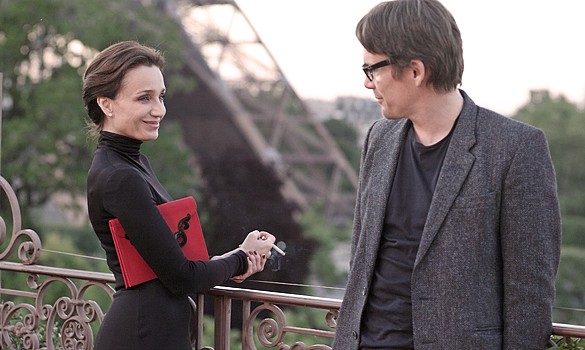Okay, I finished Douglas Kennedy's The Woman in the Fifth.
What I liked: The smooth, easy writing style. A nice feel for Paris and its various neighborhoods. The plot that hooks you right from the get-go.
What I disliked: The big plot twist. The Reveal.
I knew where this book was going, and I didn't want it go there because I knew Kennedy wouldn't be able to climb his way out of such quicksand. That said, it was still compulsive reading. Kennedy, who admits that he was inspired by this time out by Georges Simenon, tries very hard to create a fever dream, and he more or less succeeds. We're aware of the whole unreality of the set-up from the get-go, the exotic, menacing strangeness, and that's fine, I dug that. But after that... It just got too silly, but Kennedy, either wisely or unwisely, plays it straight-faced until the end.
Still, I want to read more of Kennedy and I want to see the upcoming film version of it, starring Ethan Hawke and Kristin Scott-Thomas, directed by Pawel Pawlikowski (the intriguing My Summer of Love).
W. Eugene Smith (#2)
Professional Photographer's second greatest photographer of all time. Smith (1918-1978), an American, Wichita-born, set out about on a lifelong quest to find the truth; he died broke, with $18 to his name.
Smith learned the craft of photography from his mother, and he caught a career-defining break at twenty-one when his reputation achieved through numerous magazine work led to an assignment covering the war in the Pacific. He photographed the war from the air, on land, from the sea, snapping indelible, conscious-raising images of Japanese victims and prisoners. Back at home, recuperating from a war injury, he created one of his famous photos, of his son and daughter walking through the woods.
For the next decade, Smith worked on a serious of photo essays for Life which were remarkable for the intensity and compassion, the intimacy, of the subjects he shot. Later projects included photos for a book on Pittsburgh and, during the sixties, a huge collection of photos done from his New York City window, capturing the life on the streets.
 |
| The Walk to Paradise Garden, 1946 |
Davy Jones of the Monkees died today! I love the Monkees, I really do, always did, always will. There was something so infectious, so sunny about them, and talk about hooks! I thought they were the perfect combination of power-pop and Beatles-lite, their songs a little trickier and fuzzier, garage-y and out there in a way than what I would expect. And those songs!
- "Daydream Believer"
- "A Little Bit Me, A Little Bit You"
- "(I'm Not Your) Steppin' Stone"
- "Pleasant Valley Sunday"
- "Girl"
- "Last Train to Clarksville"
- 'Daddy's Song"
- "I'm a Believer"
- "Randy Scouse Git"
R.I.P.
And musically speaking, every once in a while my mind is truly blown. Smithsonian magazine has an article this month on influential female bassist Carol Kaye, a woman I had never heard of. Turns out, she is one of the greatest bassists, male or female, of all time, a truly forgotten figure. She grew up poor to struggling musician parents in L.A. and, to make money, began teaching guitar at the age of fourteen. Over her fifty-five year career, she has played bass on over 10,000 recordings, including some songs you might have heard once or twice:
- "Homeward Bound" (Simon and Garfunkel)
- "California Girls," "Sloop John B" (The Beach Boys)
- "I'm a Believer" (The Monkees)
- "Feelin' Alright" (Joe Cocker)
- "Mission Impossible theme" (Lalo Schifrin)
- "You've Lost that Lovin' Feelin" (guitar) (The Righteous Brothers)
- "The Way We Were" (Barbara Streisand)
- "These Boots Are Made For Walkin' (Nancy Sinatra)
- "The Beat Goes On" (guitar) (Sonny & Cher)
- "Then He Kissed Me" (guitar) (The Crystals)
- "La Bamba" (guitar) (Ritchie Valens)
- "Summertime" (Sam Cooke)
 |
| Off to join Whitney... |

No comments:
Post a Comment